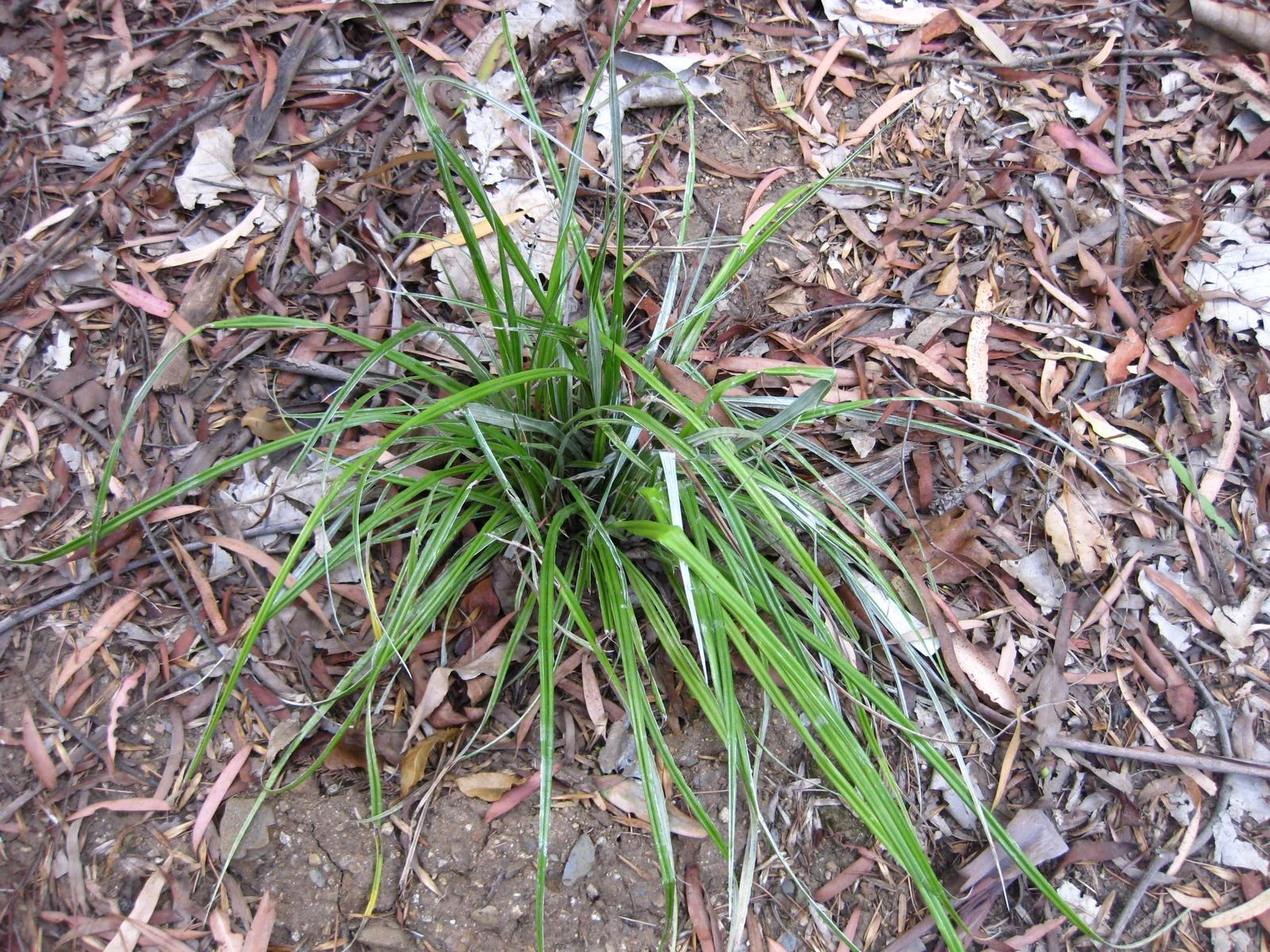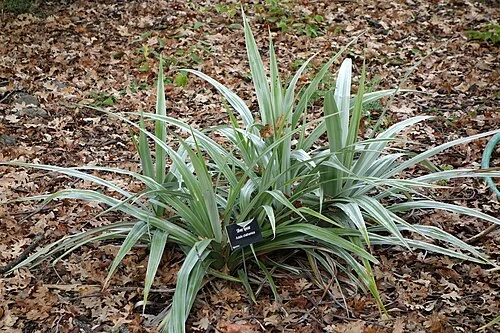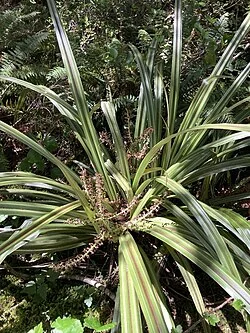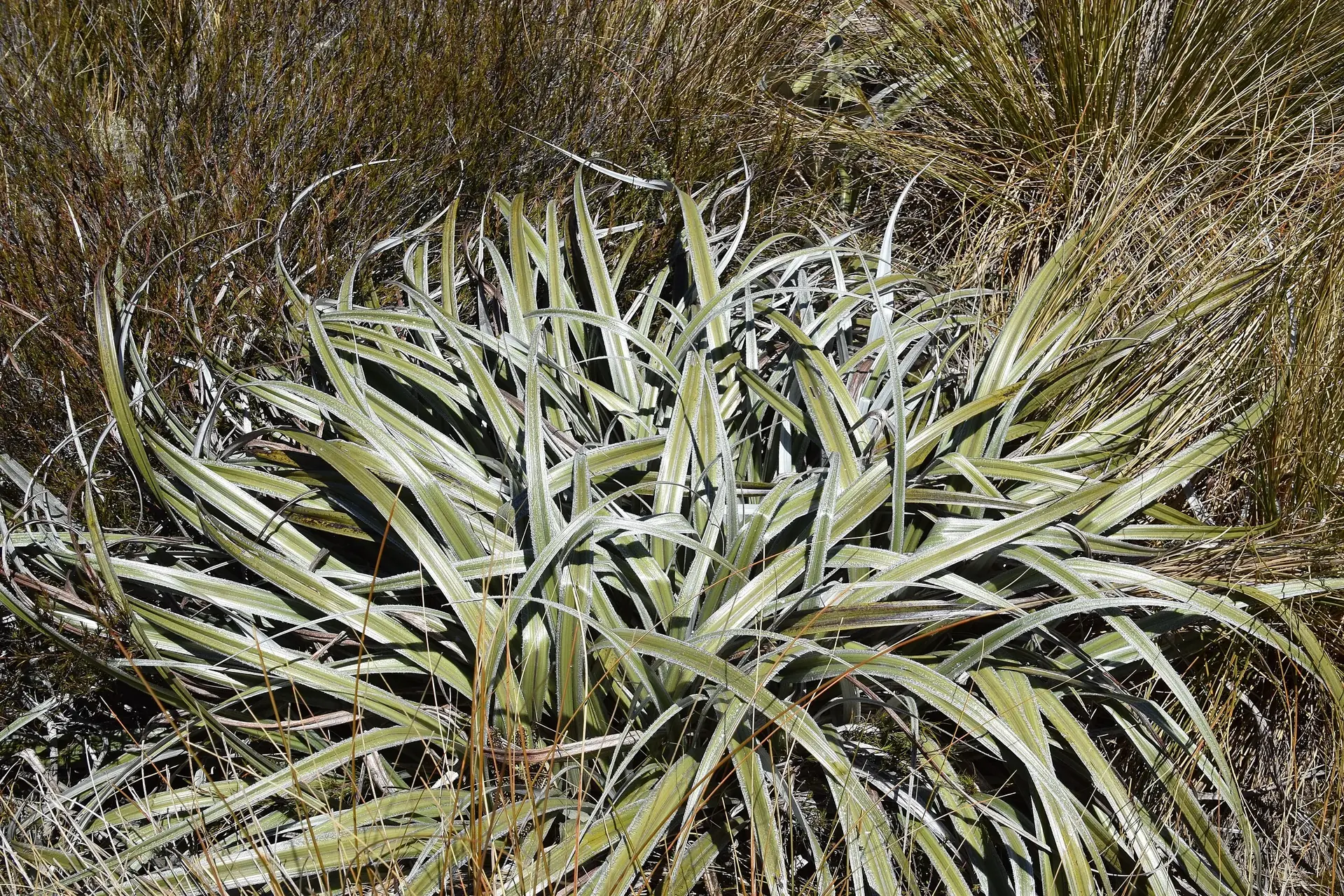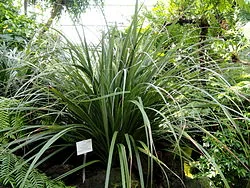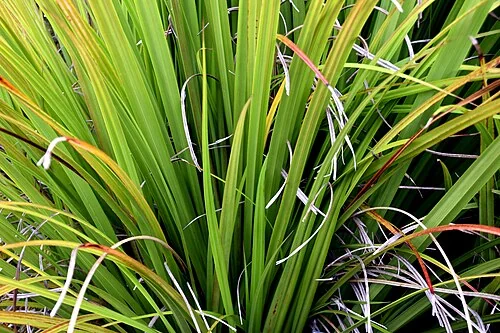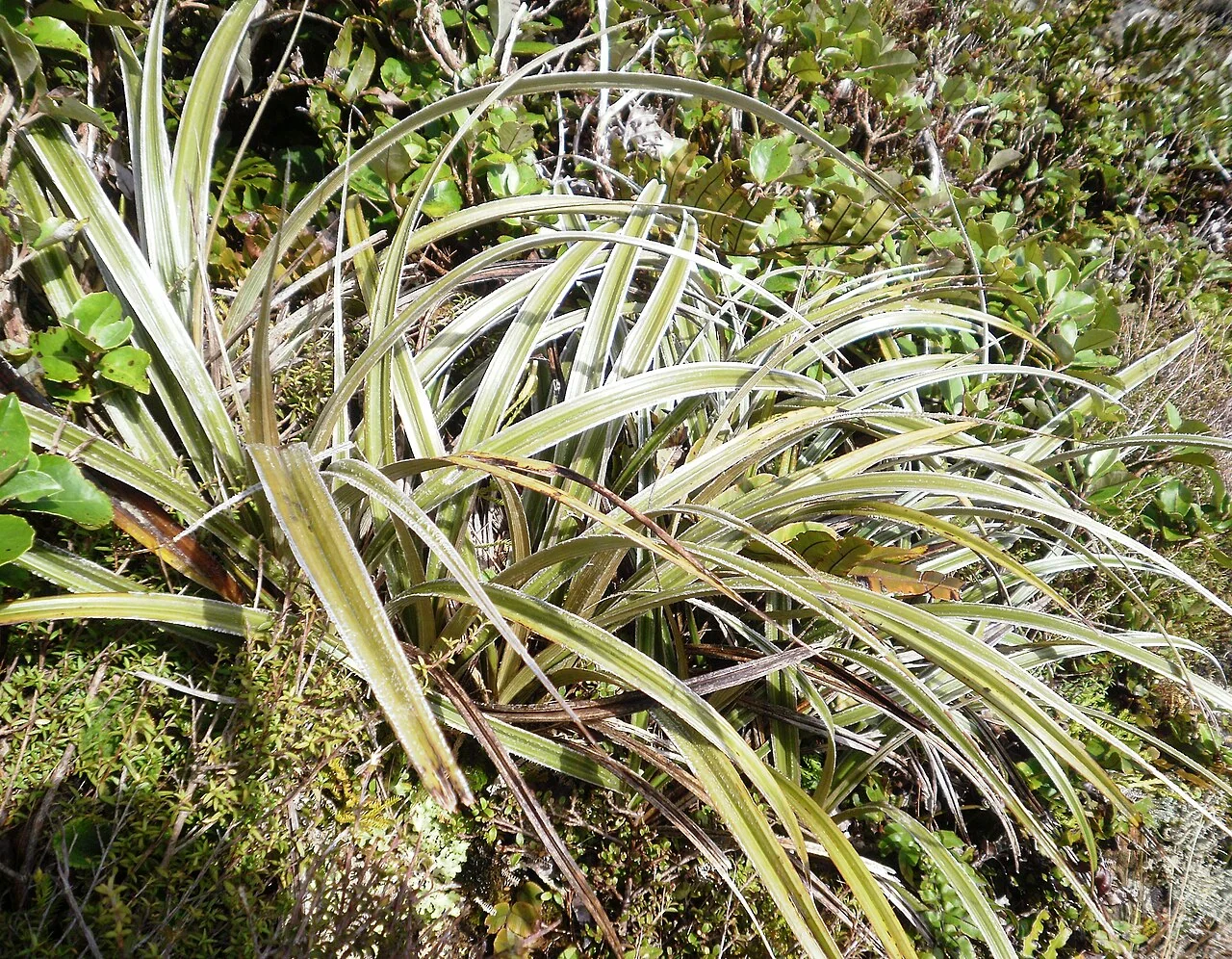
Mountain Astelia
Astelia nervosa
Explore more NZ native plant guides in our index .
Introduction
About Mountain Astelia
Astelia nervosa , commonly known as Mountain Astelia or Bush Astelia, is a striking perennial herb native to New Zealand. It forms large, architectural clumps of sword-shaped leaves that are typically green with a silvery sheen on the undersides. In spring, it produces inconspicuous flowers followed by attractive orange berries in autumn. This plant is highly valued for its dramatic foliage and is a prominent feature of subalpine and montane landscapes.

Plant Description
Botanical Features
Astelia nervosa , or Mountain Astelia, is a robust, clump-forming perennial herb, renowned for its striking architectural presence. It features long, sword-shaped leaves that can grow up to 1.5 meters in length, forming a large, dense tussock. The leaves are typically a vibrant green, often with a distinct silvery-blue sheen on the undersides, and are ridged with prominent parallel veins. The plant produces small, inconspicuous, brownish-red flowers on a tall spike, which are followed by bright orange, fleshy berries that are a valuable food source for native birds.
Quick Facts
Plant Summary
| Scientific Name | Astelia Nervosa |
|---|---|
| Height | 0.5-1.5 m |
| Spread | 1-2 m |
| Water Needs | Moderate to high; prefers consistently moist soil |
| Light | Partial shade to full sun |
| Frost Tolerance | High |
| Salt Tolerance | Low |
| Growth Rate | Moderate |
| Lifespan | Perennial |
Climate Best Suited to
Astelia nervosa is found in subalpine and montane forests, scrub, and grasslands throughout New Zealand. It thrives in cool, moist, and exposed environments.
Regional Suitability
| Whangārei | Ideal |
| Auckland | Ideal |
| Hamilton | Suitable |
| Rotorua | Suitable |
| Tauranga | Ideal |
| Gisborne | Ideal |
| New Plymouth | Ideal |
| Whanganui | Ideal |
| Palmerston North | Suitable |
| Napier | Ideal |
| Wellington | Ideal |
| Nelson | Ideal |
| Christchurch | Suitable |
| Dunedin | Suitable |
| Invercargill | Suitable |
| City | Climate Suitability |
|---|
Habitat
Where It Grows
Astelia nervosa , also known as Mountain Astelia or Kakaha, is native to New Zealand. It is typically found on mountainsides in forests and damp grasslands, specifically in the montane to sub-alpine zones between latitudes 37 and 47° south. It thrives in moist, well-drained soils and can tolerate semi-shade to full sun, though it prefers partial shade. This evergreen perennial is well-adapted to a range of growing conditions, including coastal environments.
Plant Conservation
Threats and Efforts
Mountain Astelia ( Astelia nervosa ), also known as Kakaha, is a native New Zealand perennial herb with a national conservation status of "Not Threatened." This classification reflects its widespread presence and adaptability across various montane and sub-alpine environments throughout the North and South Islands.
Despite its secure national status, local conservation efforts are important to protect its diverse habitats, which include forests, scrub, and grasslands. While the species is resilient, it can be vulnerable to habitat degradation and changes in environmental conditions, particularly in localized areas. The distinction between North Island and South Island forms, with potentially different leaf characteristics, highlights the ongoing need for botanical research and monitoring to ensure the conservation of its genetic diversity. Its popularity in cultivation also contributes to its conservation by raising awareness and ensuring its continued presence in gardens. By supporting the protection of its natural environments and promoting responsible cultivation, we can help safeguard this striking and ecologically significant component of New Zealand's flora.
Growing Requirements
Soil Requirements
Prefers moist, well-drained, humus-rich soil.
Light Requirements
Grows best in partial shade but will tolerate full sun in cooler climates with consistent moisture.
Water Requirements
Requires consistent moisture, especially during dry periods. Do not allow the soil to dry out completely.
Planting Guide
-
When to Plant
Plant in autumn or spring.
-
Site Preparation
Choose a partially shaded site with moist, well-drained, humus-rich soil.
-
Planting and Aftercare
Dig a hole twice the width of the root ball. Place the plant in the hole and backfill with soil. Water well and apply a layer of mulch.
Ecological Significance
Astelia nervosa , also known as Mountain Astelia, Bush flax, or Kakaha, is an evergreen herbaceous perennial native to New Zealand, where it grows in grasslands and forests from lowland to low alpine areas. Its ecological significance primarily stems from its role within its native New Zealand ecosystem: it serves as a food source and for seed dispersal, as the plant produces fleshy, bright orange or red berries that are sweet and edible. These fruits are dispersed through frugivory, meaning animals consume the berries and help spread the seeds, contributing to the plant's propagation and supporting local wildlife. Astelia nervosa thrives in moist, fertile, well-drained soils and can be found in both sunny and semi-shaded conditions. While it can occasionally grow in wetlands, it is more commonly found in upland areas. The plant also serves as a host for specific insects, as evidenced by the zigzag tracks found on the undersides of its leaves, which are caused by the feeding larvae of the "astelia zigzag moth." It is important to note that while it holds ecological value in its native habitat, its ecological significance is considered minimal in regions like the UK.
Uses
Foliage Colour
Ideally suited for adding colour to the garden. Varieties range from bronze to silver to green. Excellent in pots or as a border plant in semi-shade.
Cultural Significance
Traditional Uses and Values
Mountain Astelia ( Astelia nervosa ) holds cultural significance for Māori, who used the plant for various purposes. The leaves were used for weaving, and the berries were a food source. The plant also had medicinal uses in rongoā (traditional Māori medicine).
Landscaping Uses
Garden Design Applications
Astelia nervosa , also known as Mountain Astelia, Bush flax, or Kakaha, is a distinctive evergreen perennial native to New Zealand, highly valued in landscaping for its striking foliage and unique form. Its landscaping uses include: specimen plant, mixed plantings, containers, and various garden styles such as modern, contemporary, tropical, or exotic-themed gardens. Its sculptural leaves also make it perfect for modern landscapes. It can be incorporated into beds and borders, providing handsome all-season structure. Some varieties, like 'Westland', are suitable for low garden beds. Astelia nervosa is tolerant of coastal conditions and is considered a low-maintenance plant. It can also be useful in woodland planting schemes and is considered a suitable restoration species for pioneer plantings. It prefers well-drained soils and can tolerate partial shade to full sun. It is also known to be deer-resistant.
Seasonal Care Calendar
Spring
- Apply a layer of compost or leaf mould to enrich the soil and retain moisture.
Summer
- Water regularly, especially during dry periods.
Autumn
- The berries will ripen and provide a food source for birds.
Winter
- Protect from extreme cold in colder regions.
Pruning and Maintenance
Simple Maintenance
Remove any damaged, dead, or discoloured leaves at the base to keep the plant looking tidy and maintain its striking architectural form. In late winter or early spring, tidy up by trimming back any spent or frost-damaged foliage to preserve the silvery appearance. Good air circulation around plants is essential to prevent crown rot, so ensure proper spacing and avoid planting too deeply. The striking silvery-blue foliage requires minimal intervention to maintain its natural beauty.
How to Grow Mountain Astelia
Seeds
Seed propagation is the natural reproduction method for Mountain Astelia, though it requires specific cold treatment to break dormancy and achieve successful germination. This alpine species produces orange fruits containing viable seeds that have evolved to survive harsh mountain conditions through cold winter periods before germinating in spring. For successful cultivation, seeds require 4 weeks of cold stratification to simulate natural winter conditions and break dormancy mechanisms. Begin by collecting fresh seeds from ripe orange fruits during autumn, cleaning away all fruit pulp as residual material can inhibit germination and promote fungal growth. Store cleaned seeds in slightly moist sphagnum moss or sterile sand in sealed containers in the refrigerator at 2-4°C for the required 4-week stratification period. After stratification, sow seeds in a well-draining seed-raising mix, covering lightly as they require some light for optimal germination. Maintain consistently moist conditions at temperatures around 15-18°C, providing bright indirect light without direct sunlight. Germination typically occurs within 3-6 weeks after stratification, though some seeds may take longer to emerge. Young seedlings develop slowly initially, forming small rosettes of the characteristic leathery leaves before developing more substantial root systems. Transplant seedlings when they have developed several mature leaves and strong root systems, typically after their first growing season. Seed-grown plants typically take 2-3 years to reach substantial size and may show natural variation in leaf colour and growth habit. This method is particularly valuable for restoration projects where genetic diversity is important, and for gardeners seeking to grow plants adapted to specific local conditions. Commercial seeds are available from specialized New Zealand native plant suppliers, typically sold in packets of 100 seeds for those undertaking larger propagation projects.
Division
Division provides the most reliable and straightforward propagation method for Mountain Astelia, taking advantage of the plant's natural clumping growth habit to create new plants identical to the parent. This method is particularly effective for home gardeners who want to multiply existing plants or for creating consistent plantings where uniform appearance is desired. The optimal timing for division is during spring when new growth begins to emerge, allowing divided sections to establish quickly in favorable growing conditions. Begin by carefully lifting the entire clump using a garden fork, working around the perimeter to avoid damaging the substantial fibrous root system. Mountain Astelia forms distinct basal rosettes that can be identified as natural division points where separate growing centers have developed. Once lifted, gently shake away excess soil to expose the root structure and identify these individual rosettes with their associated root systems. Use a sharp, clean knife or spade to cut through connecting root material, ensuring each division includes both healthy roots and at least one complete rosette with intact growing points. Each division should have sufficient root material to support the foliage, as the long, flexible leaves require substantial water and nutrient uptake. Divisions can be quite generous in size, as larger sections establish more quickly and provide immediate visual impact in garden settings. Replant divisions immediately in prepared soil enriched with organic matter, positioning them at the same depth they were previously growing. Choose locations that provide partial shade with fertile, free-draining soil, as this species naturally occurs in damp but not waterlogged mountainous areas. Space plants 60-80cm apart to accommodate their natural spread of up to 90cm and ensure good air circulation around each clump. Water thoroughly after planting and maintain consistent moisture during the establishment period, particularly during dry spells as recommended for this species. This method maintains all the distinctive characteristics of the parent plant, including the attractive silvery-green foliage that makes Mountain Astelia such a valued architectural plant in New Zealand gardens.
Cultivar Selection
Cultivar selection offers an excellent approach for gardeners wanting to grow Mountain Astelia with specific characteristics, taking advantage of superior forms that have been selected and propagated for garden use. Several distinctive cultivars are available commercially, including 'Westland' and 'Westland Red', which have been selected for their enhanced coloration and garden performance. The 'Westland' cultivar is particularly notable for its silver-red foliage that provides striking colour contrast in garden settings, while maintaining the hardy characteristics of the species. These cultivars are typically propagated through division by specialist nurseries to maintain their exact characteristics, ensuring gardeners receive plants with consistent and superior qualities. When selecting cultivars, consider both the specific growing conditions in your garden and the desired aesthetic effect, as different forms may vary in their mature size, leaf coloration, and environmental tolerance. Purchase plants from reputable nurseries that specialize in New Zealand native plants, as they are more likely to stock authentic cultivars and provide accurate growing information. Many cultivars are available in various container sizes, from small seedling-stage plants to more substantial specimens that provide immediate impact. While cultivar plants may be more expensive than species plants grown from seed, they offer the advantage of known characteristics and often superior garden performance. Establishment care for cultivars follows the same principles as species plants, requiring fertile, free-draining soil in partial shade with regular watering during dry periods. Some cultivars may be slightly less hardy than the species, particularly those selected for enhanced foliage colour, so consider local climate conditions when making selections. This approach is ideal for gardeners who want to achieve specific design goals or who prefer the reliability of proven garden performers rather than the variability that can occur with seed-grown plants.
Pests and Diseases
Leaf Spots
Can be prone to fungal leaf spots in humid, stagnant conditions. Ensure good airflow. Scale insects may hide in the leaf bases-inspect regularly.
Bonus Tip
Architectural Garden Impact
Mountain Astelia ( Astelia nervosa ) is one of the most architecturally striking native plants you can grow, creating instant focal points with its dramatic sword-shaped leaves and distinctive silvery sheen. For maximum visual impact, plant it as a specimen in a prominent position where its sculptural form can be fully appreciated, such as at the entrance to a garden path, in a large container on a patio, or as a centerpiece in a mixed native planting. The key to showcasing its beauty is providing adequate space around the plant so its natural form isn't crowded, allowing the elegant arch of the leaves and the stunning colour contrast between the green upper surfaces and silvery undersides to be fully displayed. Consider backlighting the plant with subtle garden lighting to highlight its architectural qualities during evening hours, creating a spectacular effect that transforms the garden after dark.
